
| Palaeos |  |
Chelonii |
| Vertebrates | Chelydridae |
| Page Back | Unit Home | Unit Dendrogram | Unit References | Taxon Index | Page Next |
| Unit Back | Vertebrates Home | Vertebrate Dendrograms | Vertebrate References | Glossary | Unit Next |
|
Abbreviated Dendrogram
ANAPSIDA ? | o CHELONII |--Odontochelys `--+--Proganochelys `--+--Proterochersis `--+--Pleurodira |--Paracryptodira `--+--Protostegidae `--+==Xinjiangchelyidae `--o Centrocryptodira |==Sinemydidae |--Trionychoidea `--+==Macrobaenidae |--+--Chelonioidea | `--+--Emarginachelys | |--o Chelydroidea | | |--o Platysternidae | | | |--Macrocephalochelys | | | `--Platysternon | | `--o Chelydridae | | |--Protochelydra | | `--Chelydrinae | `--Kinosternoidea `--Testudinoidea |
Contents
Overview |
Taxa on This Page
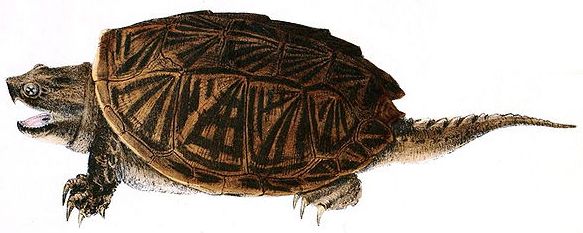 |
| Common Snapping Turtle, Chelydra serpentina, hand-colored lithograph, John Edwards Holbrook, 1842, North American herpetology; or, A description of the reptiles inhabiting the United States, modified from Biodiversity Heritage Library, public domain, via Wikipedia |
The Chelydrids or snapping turtles are aquatic ambush predators known today from only two species from North and Central America, although during the Tertiary they were more widespread, ranging across Eurasia. They are distinguished by a lack of advanced characteristics (synapomorphies) which is why in the cladistic studies of Gaffney and co-workers they are placed as the most basal of extant cryptodires. Molecular phylogeny however positions them in a more derived group, along with Chelonioids (sea turtles) and Kinosternoids (mud and musk turtles).
The Asian genus big-headed turtle Platysternon megacephalum has been unanimously related to the Chelydridae on morphological cladistic grounds, but equally unanimously excluded on the basis of molecular phylogeny, which places it instead in the tortoises and terrapin crown group (Superfamily Testudinoidea), which makes no morphological sense (there are many similiar morphological nonsensical placements based on molecular phylogeny, e.g. turtles as crown group archosaurs, and insectrs as crown group crustacea). Although we have for the most part followed the current consensus, the premise that molecular sequencing should automatically confer a more reliable phylogenetic signal than morphology is something that has, to the present writer's knowledge, not been empirically tested. Just to be different, we decided to use a morphology-based interpretation. MAK130403
Range: Fr the Paleocene
Phylogeny: Chelonioidea-Chelydridae-Kinosternoidea clade : Panchelonioidea + (Emarginachelys + Kinosternoidea + * : Chelydridae + Platysternidae)
Comments: An informal morphology-based taxon, which may be paraphyletic or, if molecular phylogeny is any indication, polyphyletic. The Chelydroids are first known from the Paleocene. Emarginachelys, may belong here as well (e.g. Carroll, 1988, p.616), or it may be related to the Kinosternoid, or for that matter to both groups (which would fit with Molecular phylogeny which places the Chelydridae and Kinosternoidea close together) MAK130403
Range: Paleocene to Recent
Phylogeny: Chelydroidea : Chelydridae + * : Macrocephalochelys + Platysternon
Characters: well-developed maxilla-postorbital contact (Gaffney 1975b)
Comments: The family Platysternidae contains only one living species, Platysternon megacephalum Gray, 1831, the big-headed turtle of South-East Asia. This species is distinguished from other freshwater turtles by its enormous head that cannot be retracted into the shell, its unusually long tail, and flat carapace (ref). Apart from Macrocephalochelys, whose placement here is by no means unambiguous, the only fossil representatives are a few highly fragmentary specimens from the Oligocene and Paleocene of Kazakhstan. (Joyce et al 2004 p.1005). For the controversy regarding the overall phylogenetic placement of this family, see Platysternon: comments. MAK130403
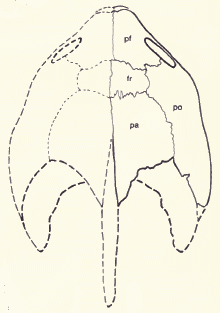 |
| Macrocephalochelys pontica, dorsal view. Restoration from Pidoplichko and Tarashchuk (1960), via Gaffney (1975b) fig 1D, p.165. The partial nature of the specimen is evident from the dotted lines. |
Macrocephalochelys pontica Piboplichko and Taraschchuk, 1960
Range: Pliocene of Ukraine
Phylogeny: Platysternidae : Platysternon + * :
Comments: Known from a partial skull, it was it was interpreted as a near relative of Platysternon by Piboplichko and Taraschchuk. Chkhikvadze (1971) placed it in the Chelydridae without Platysternon, while Gaffney 1975b reaffirmed Piboplichko and Taraschchuk's interpretation, placing the two taxa together in the Subtribe Platysternina. The subtribe ranking is because Gaffney follows Hennig in interpreting Linnaean ranks in terms of phylogenetic branching sequence. Because the two systems are incompatible we have restored the family Platysternidae. MAK130403
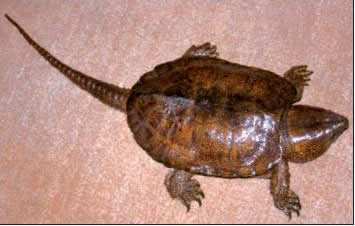 |
| Platysternon megacephalum. Photo from the European Freshwater Turtle Breeders Association. |
Platysternon megacephalum Gray, 1831
Range: Recent
Phylogeny: Platysternidae : Macrocephalochelys + * :
Comments: The Asian big-headed turtle. The phylogenetic placement of this species is highly controversial, and represents a major incongruency between morphology-based cladistics and testudine molecular phylogeny.
Hennigian morphological studies interpret Platysternon as a derived (Gaffney 1975b, Gaffney & Meylan 1988) taxon within the Chelydridae. The recent statistical parsimony cladistic analysis of Joyce 2007 resolves P. megacephalum as related to both testudinoids and trionychoids, whereas the still more recent analysis of Anquetin, 2009, which incorporates Joyce's data, instead unambiguously places Platysternon as the sister group of panchelydrids (Anquetin, 2009 p.203).
Early molecular sequencing results recovered a sister group relationship between Platysternon megacephalum and the Testudinoidea does have some precedent, and this led Joyce et al 2004 to revive the old taxon Cryptoderinea. The Cryptoderinea was named by Vaillant (1894), who united Platysternon and Testudinoids based on the unique arrangement of the articular surfaces on their cervical vertebrae. Williams (1950) reached the same conclusion in his comprehensive review of turtle cervical vertebrae. Joyce et al 2004 therefore selected the Cryptoderinea Vaillant, 1894 as the crown clade arising from the last common ancestor of Platysternon and the Testudinoidea, with Pancryptoderinea as the stem-group (Joyce et al 2004 p.1004-5).
However greater refinement of molecular sequencing nested Platysternon in the crown Testudinoidea as sister taxon to the Emydidae (Barley et al 2010, Thomson & Shaffer 2010, Guillon et al 2012), a placement that makes no morphological sense at all, at least as far as recent taxa go. Interestingly, the problematic fossil testudine Acherontemys from the Miocene of North America may have features of both groups, as it was assigned to Chelydridae by Hay and to Emydidae by Hutchison (1992).
Even so, it seems that the current paradigm requires that whenever there is a lack of agreement between morphological and molecular phylogenies, the latter must automatically be preferred, despite the two being equally robust, and for this reason Platysternon (and the monotypal family Platysternidea) are now unanimous placed it in the superfamily Testudinoidea. Without additional methodologies or total evidence it is difficult to go beyond this gridlock. Unfortunately to date there has been no combined approach beyond the early work of Shaffer et al. 1997 and the rather surreal tree of Sterli 2010 (which nests Pleurodires in Crown Cryptodira). Another hypothesis, which would conflict both morphologicak and molecular analyses, is that Platysternon is a transitional form between the Chelydridae and the Testudinoidea. For now we have followed Anquetin, 2009. MAK130305
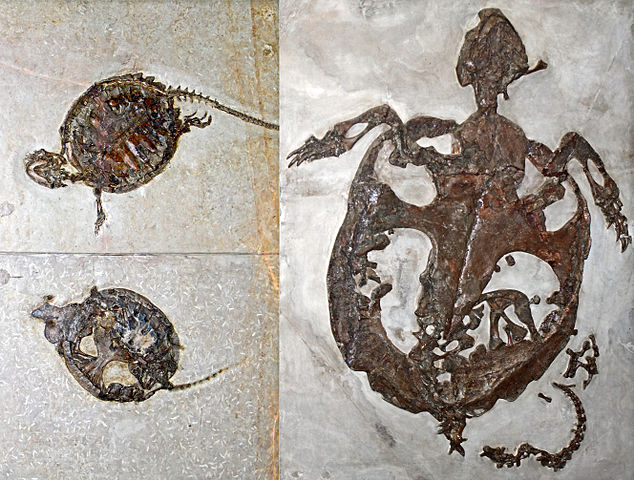 |
| Chelydropsis murchisoni, Chelydridae; left: juvenile (plate and counter plate), right: adult; Miocene, Öhningen layers, Öhningen, Germany; Staatliches Museum für Naturkunde Karlsruhe, Germany. Photo by H. Zell, GNU Free Documentation/Creative Commons Attribution license; via Wikipedia. |
Chelydridae = Panchelydridae Joyce et al. 2004
Range: Fr the Paleocene
Phylogeny: Chelydroidea : Platysternidae + * : Protochelydra + Chelydrinae
Characters: medial contact of abdominal scales absent; anal scales overlap medially onto hypoplastra (Anquetin, 2009 p.203)
Comments: The American snapping turtles. As with the morphologically very similar but genomically distinct Asian genus Platysternon, the phylogenetic position of this group is quite uncertain, although this ambiguity goes for chelonii in general. Hennigian morphologists (e.g. Gaffney et al 1991; Gaffney, 1996) consider the Chelydridae the most primitive extant cryptrodires, computational cladistics (e.g. Joyce 2007, Danilov & Parham, 2008, Anquetin, 2009) makes it the second most basal after the Chelonoidea, and molecular phylogenists (e.g. Krenz et al 2005, Barley et al. 2010) placed in a Kinosternid-Chelydrid-Chelonioid clade, and sometimes within that clade as sister group to the Kinosternids, MAK110922
Range: Late Paleocene of North Dakota
Phylogeny: Chelydridae : Chelydrinae + *
Characters: "Chelydrid turtles having a relatively larger jugal and greater posterodorsal and cheek emargination than in Chelydrinae; triturating surfaces of skull relatively wide in comparison to most Chelydrinae; posteriorly directed ridge on ventral surface of pterygoid present; plastron cruciform, as in Chelydra and Macroclemys, but apparently lacking median fontanelles." (Gaffney 1975b)
Comments: The earliest known chelydrid. Its carapace is higher domed than the Recent Chelydra, perhaps as a defense against chelonivorous (i.e., turtle-eating) crocodilians ( Jehle, 2006). Gaffney (1975b) places it in its own subfamily, the Protochelydrinae, MAK130306
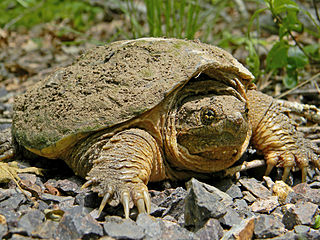 |
| A common snapping turtle, Chelydra serpentina, photographed at Taum Sauk Mountain State Park. Photo by Dakota L., Creative Commons Attribution license, via Wikipedia |
Chelydrinae Chelydra serpentina + Macrochelys temminckii)
Range: Fr the Oligocene
Phylogeny: Chelydridae : Protochelydra + *
Characters: retention of a central plastral fontanelle in adult individuals Anquetin, 2009 p.203)
Comments: The Chelydridae or snapping turtles of the family are aquatic ambush predators with large heads, thick hooked beak and strong jaws and long scaly tails. There are two extant species: Chelydra serpentina, the Common Snapping Turtle, and its larger relative Macrochelys temminckii, the Alligator Snapping Turtle, both endemic to the Western Hemisphere (North and Central America). The latter genus is famous for lying in ambush open-mouthed, attracting fish with its moving worm-like tongue until the heavy jaws rapidly close on its prey. Chelydrids are the only group that can retract the head with jaws wide open. They are are slow swimmers, and feed on plants, carrion, or anything that moves. About 20 to 40 spherical eggs are laid. As with many aquatic turtles there is a reduction of the heavy shell; in this case the plastron is connected to the carapace by ligament rather than heavy bone (Refs: Wikipedia Family Chelydridae @ itech.pjc.edu (no longer online)).
There are a number of fossil forms, although no cladistic analysis has been done to determine their phylogeny. Chelydropsis, contains several well known Eurasian chelydrid species that existed from the Oligocene to the Pliocene. (refs, Wikipedia). The extant genera Chelydra and Macrochelys are reported from the Oligocene and Miocene respectively (Carroll, 1988, p.616). On the basis of morphological analysis of features of the skull, Gaffney (1975b) considers Macrochelys closer to Platysternon than to Chelydra, placing the foremer two in Tribe Platysternini andthe latter in Tribe Chelydrini. MAK110922 130306
| Page Back | Unit Home | Page Top | Page Next |
Page last modified MAK130403. Creative Commons Attribution License Version 3.0, and may be freely used provided acknowedgement is given. All Wikipedia material is either Gnu Open Source or Creative Commons (see original Wikipedia page for details). Other graphics are copyright their respective owners